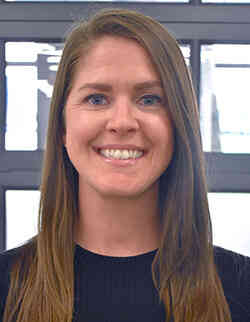The Leon Root, MD, Motion Analysis Laboratory
Motion analysis is the assessment of one's movements, used to help diagnose, rehabilitate, or prevent physical injuries from occurring. The Leon Root, MD, Motion Analysis Laboratory is a state-of-the-art facility for the collection, analysis, and interpretation of human movement data on individuals of all ages with orthopedic, rheumatic, and neurological diagnoses. We are accredited by the Commission for Motion Laboratory Accreditation, Inc (CMLA) and one of only 3 labs in the United States that evaluates both children and adults.
The Leon Root, MD Motion Analysis Laboratory is a 93' x 27' space with state-of-the-art design and measurement capabilities. Our laboratory can be rapidly reconfigured to fit the needs of each individual patient, from a young child with cerebral palsy to an athlete with sports-specific concerns.
What is Motion Analysis?
Motion analysis is a technique that allows clinicians to quantify human movement patterns. It combines an examination of an individual’s physical structure with measurements of their function during activity.
Our clinical testing typically quantifies an individual’s ability to walk. However, since changes in movement patterns are seen during other activities, such as throwing, running, and jumping, research projects are underway to examine these advanced skills. Current and past research studies assessed motions during pitching, football throwing, golf club swinging, running, kicking, dart throwing, sit-to-stand, and stair climbing.
Physicians and healthcare professionals use motion analysis when additional expert knowledge is needed to plan both nonsurgical and surgical treatments. Motion analysis provides a quantitative perspective that may not otherwise be easily measured.
Your healthcare provider will determine if the addition of a motion analysis test at the Leon Root, M.D. Motion Analysis Laboratory would benefit your treatment plan. If they have questions, please have them contact us at 212.606.1215.
Gait Analysis and Functional Testing
The two most common types of testing performed are gait analysis and instrumented strength testing. A physical therapy evaluation is the first step in the testing process.
Based on the physician referral and physical therapy evaluation, patient-specific tests are performed.
Gait analysis tests may include:
- Electromyography (EMG) activity
- Joint kinematics and kinetics
- Plantar pressures
- Temporal and distance gait parameters
- Video analysis
Functional testing tests may include:
- Isometric/isokinetic dynamometry
Our Vision
- To be a leader in the study, analysis, and interpretation of movement in individuals with or without neuromusculoskeletal conditions
Our Mission
- To provide the highest quality of clinical movement analysis and biomechanical research to guide treatment and to investigate neuro-musculoskeletal conditions for enhanced mobility and quality of life for all
- To be the specialists in mobility assessment supporting the HSS mission, vision, and values to improve mobility and enhance the quality of life for all
Motion Analysis Test & Measures
A gaitmat is a computerized walkway that records the characteristics of a patient's walking mannerisms (i.e. distance covered per step, average walking speed, etc.) The gaitmat is capable of real-time quantitative analysis of temporal and distance gait parameters. The surface of the walkway contains small switches arranged in rows. The switches are in an open position, when a subject walks across the mat the switches close and then reopen as the subjects feet come in contact and break contact with the mat.
When a switch closes and reopens, the computer records the closing and opening times. As a result, the temporal and spatial characteristics (stride length, double support time, step length, step time, average velocity, etc) of the patient’s gait are obtained.
Joint kinematics is the study of the positions, angles, and velocities of body parts/joints when in motion. The lab has a 14-camera motion capture system to collect 3D kinematic data in a volume approximately 4m x 10m x 2.5m. The system can be used to analyze joint motions in the body. Kinematics can be collected during walking and selected tasks in certain individuals.
Our large data capture area allows data capture for both clinical patients and research studies ranging from arm functioni to walking.
Joint kinetics refers to the forces transmitted by the motion of muscles, tendons, ligaments, and bones. To measure kinetics, four force plates measuring the ground reaction force are installed within an epoxy leveled and isolated 10’ x 14’ pit. Force plate technology is useful in both clinical and research applications as it allows us to see joint forces, powers, and limits. Allowing us to see how much force is acting on a patient’s joints; a useful piece of data to help compile a complete analysis.
The lab has an instrumental stair system which can be set up in our motion capture area and works in coordination with our force plates. The stair system allows us to capture a patient using stairs through our 3D motion capture system (allowing us to see the angles of movement) and the forces the patient exerts on their joints while they climb the stairs (allowing us to quantify the force the patients joints are encountering).
Plantar pressure is a measurement that identifies and quantifies areas of high pressure (stress) in one's feet. The insole plantar pressure wireless system is designed to measure in-shoe pressures. Each insole contains an array of high quality capacitance sensors. In-shoe plantar pressure distribution assessment allows physicians to evaluate how various foot orthoses, braces, or shoe designs affect atypical loading under the feet.
The barefoot plantar pressure system is designed to measure the distribution of pressure on the barefoot while walking or standing. The system consists of a pressure plate, placed on the walkway, level with the floor.
The data obtained from the pressure plate can be analyzed using the equipped software to determine peak pressure, pressure time integral, and maximum force under different regions of the foot. In addition, a custom-developed program is used to calculate certain parameters of interest, including the Center of Pressure Excursion Index (CPEI), peak pressure, foot angle, and the temporal sequence of loading for three phases of stance.
Electromyography (EMG) is a medical technique used to evaluate and record the electrical activity produced by skeletal muscles. EMG electrodes are used in coordination with our motion capture system, allowing us to see which muscles are working properly. With the aid of EMG, abnormalities can be detected within the muscular system and how the muscles are working with the patient’s skeletal system. EMG’s are very useful for patients undergoing rehab (to track progress) and for patients with neuromusculoskeletal conditions (to better understand how our patients may be better treated).
The lab has two isometric/isokinetic dynamometers to measure strength in the lower and upper extremities. They are used to test post-operative strength or changes in strength during the course of therapy. Our dynamometers are useful for quantifying muscle strength and allow us to systematically observe how well a patients muscle is functioning.
The Malleolar Valgus Index (MVI) is a static measurement taken with a flatbed computer scanner. An MVI value is helpful in categorizing the structure of a foot along a spectrum containing planus (flat-foot), rectus (ideally-aligned), and cavus (high-arched) feet.
To make an MVI measurement a plexiglass platform is placed over the flatbed scanner and a custom-made MVI jig is fitted to the medial malleolus and lateral malleolus (the ankle bones). A scan of the foot is then made in grayscale and posterized to eight levels which allows for a better view of the foot’s contact with the ground.
The first metatarsal phalangeal joint flexibility device is designed to measure the flexibility of the first metatarsal phalangeal joint. After securing the patient’s foot in the device, the operator rotates the plate secured to the big toe toward the top of the foot while moment and angle data are collected. The flexibility of the first metatarsophalangeal joint is estimated as the slope of the moment versus angle curve.
Arch heights are measured in order to characterize foot shape and foot structure. The measurement also allows us to compare these characteristics between a sitting and a standing position. A left and right device is used to measure the foot length and truncated foot length (foot length from the heel until the first metatarsophalangeal joint). The arch height is then measured from ½ the footlength with a free-falling bar.
Testing may only occur at the request of your physician. Your physician should contact us about the appropriate testing for your condition.
Prescriptions
For a patient to be seen in the Leon Root, M.D. Motion Analysis Laboratory, a medical prescription from your referring physician is required. This prescription must be presented at the time of your initial visit. Prescriptions should be dated within 30 days of testing.
Length of Motion Analysis Testing
Walking tests usually take a total of 2-3 hours. The first part is an assessment of your overall structure (joint range of motion, muscle strength, postural alignment, etc.). Assessments take about one hour. The second part is a computerized function test lasting an average of 1-2 hours. Muscle strength testing takes a total of an hour.
Attire
For walking tests, bring shorts and a sleeveless shirt or a sports bra to change into. We will inform you of any further attire requirements once your appointment is scheduled.
Cancellations
It is your responsibility to cancel your appointment 24 hours in advance.
Postdoctoral Fellow
Our four research focus areas include:
Movement Dysfunction Mechanisms
- Osteoarthritis (shoulder, wrist, knee, ankle, 1st MTPJ)
- Cerebral palsy
- Scoliosis
Injury Prediction & Prevention
- Sports biomechanics (running, pitching, performance)
- Secondary osteoarthritis (ACL, meniscus)
- Joint stabilization (rotator cuff repair)
- Overuse injuries (musicians, MSK injury prediction and prevention)
Treatment Effects
- Arthroplasty (knee, ankle, shoulder, wrist)
- Surgical realignment (HTO, Scoliosis)
- Joint offloading (orthoses)
- Joint stabilization (rotator cuff repair, ACL)
- Joint preservation (wrist, rotator cuff)
- Rehabilitation (NM re-education, best practice)
See a list of current research projects.
Contact Us
Hospital for Special Surgery
Center for Advanced Movement Technologies (AMT)
510 East 73rd Street
New York, NY 10021
212.606.1215








